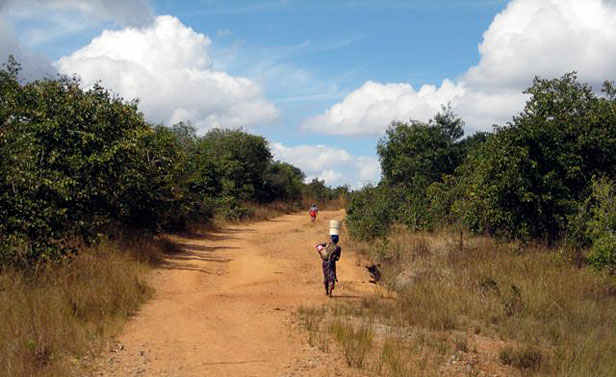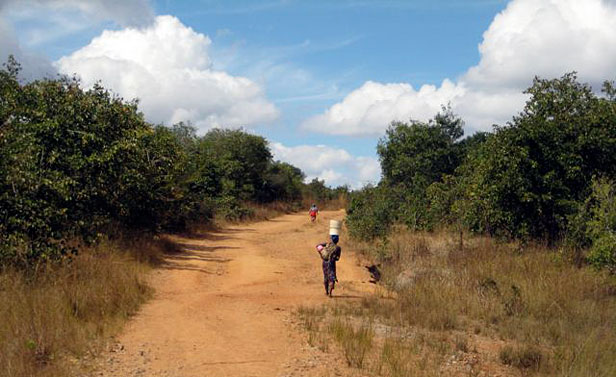 Zambian farmers grew plenty of maize without biotech seeds — so much so that it became a problem. Photo: Sam Fromartz
Zambian farmers grew plenty of maize without biotech seeds — so much so that it became a problem. Photo: Sam Fromartz
Last year, I had the opportunity to travel to Zambia for a project for Worldwatch. The massive report “State of the World 2011: Innovations that Nourish the Planet,” released Wednesday, focuses on many projects that were highly effective in both feeding people and raising incomes in Africa. Much of this work was chronicled on Nourishing the Planet blog, as researcher Danielle Nierenberg logged thousands of miles criss-crossing the continent meeting with farmers, researchers, NGOs, and government officials.
It was a refreshing perspective because so much of the discussion about agriculture in Africa focuses on production. Plant more. Increase yield. Improve seed technology. But there is really no silver bullet when it comes to food production and access, and the relentless focus on technology ends up being lopsided and incomplete — as I saw in Zambia.
The nation produces more than enough food, much of it by small-scale farmers without tractors, irrigation, or any form of transportation. But this excess food ends up rotting in warehouses and causes price crashes when it hits the market — good for buyers but dismal for small-scale farmers who depend on these sales for their meagre income.
Even so, some areas of the country still suffer from malnutrition and shortages. Why? There are many reasons, inadequate roads and supply networks among them, since it isn’t always easy to get the food from areas where it is surplus to areas where it is in short supply. In this reality, high-tech seeds are the least of the nation’s problems. And yet, on op-ed pages, that often seems to be the focus of discussion.
How come we hardly see op-eds on what paved roads, improved sanitation, more efficient distribution networks, soil conservation, and a reduction in food waste might do for world hunger? Fifteen percent of the grain harvest is wasted in poorer countries, according to a researcher quoted in this report. Even cutting that in half would amount to an enormous yield gain. The Worldwatch report attempts to jump-start this discussion by addressing these issues.
I sought to do the same in my chapter:
The Missing Links: Going Beyond Production
When people talk about African agriculture, food surpluses are not usually the focus of discussion. Invariably, the more familiar topics are famine, starvation, deforestation, and the vast inability of a continent to feed itself, which is brought home by the latest food crisis.
That’s why the headlines in Lusaka, Zambia, in May 2010, were so surprising, announcing a stunning bumper crop of maize. On the back of fertilizer subsidies and propitious rains, production by the nation’s 800,000 maize farmers had rocketed 48 percent to the highest level in 22 years. This boom came after a 31-percent rise the previous year. Now speculation was mounting about a crash in maize prices, especially during the dry June-August period. “A tidal wave of maize will be hitting the market,” predicted Rob Munro, a senior market development advisor for the U.S. Agency for International Development (AID) in Lusaka.
In the cities, the focus was on the price of mealie meal, the porridge-like staple made from ground maize, and whether millers would pass on savings or fatten their profit margins. The government was fretting about what to do with all this food. Zambia had a 600,000-ton surplus from the 2009 harvest, some of which was still sitting in warehouses. And now on top of that, it would reap a 1.1 million-ton surplus for 2010. Exports were uncertain, because of sporadic trade restrictions. Plus, the crop was uncompetitive with South African maize, the low-cost producer in the region.
Zambia was growing so much food that the food itself had become an issue. Yet, it was also an unequivocal success. Zambian farmers had produced more than enough maize and done so without genetically modified crops or even, for the most part, irrigation and mechanized farm equipment. But further development raised a number of questions: If farmers actually modernized and improved their yields, would the surplus be even greater, dwarfing any political ability to deal with this bounty? And why were people still facing chronic hunger and childhood stunting in a country where the food was in oversupply?
The rest of the chapter addresses this issue, but it was clear from even my short stay in Zambia that a lack of agro-technology was not the most pressing issue faced by the nation’s farmers. From those I talked with, it hardly seemed on the radar screen in terms of what needed to be addressed.
Ignoring technology can be disastrous, but focusing on it out of context, and without regard to a host of related concerns, can be just as perilous since it suggests that food insecurity can be solved with a silver bullet. Only problem is, silver bullets can’t be eaten.
Cross-posted with permission from Chews Wise.



